Master in Public Health: Wollongong Community Needs Assessment
VerifiedAdded on 2023/06/07
|10
|2369
|114
Report
AI Summary
This report presents a needs assessment of the Wollongong community, focusing on demographic, geographic, social, and health status characteristics. It utilizes both primary and secondary data sources, including the Australian Bureau of Statistics Census of 2016, to provide a comprehensive understanding of the community's health needs. The report also references relevant journal articles that employ methodologies such as self-administered questionnaires for assessing health behaviors and dietary habits among students, highlighting the importance of these methods for gathering data on factors like physical activity, drug use, and dietary habits. The findings aim to inform public health interventions and improve the overall well-being of the Wollongong community. Desklib offers a platform for students to access similar solved assignments and resources for their studies.
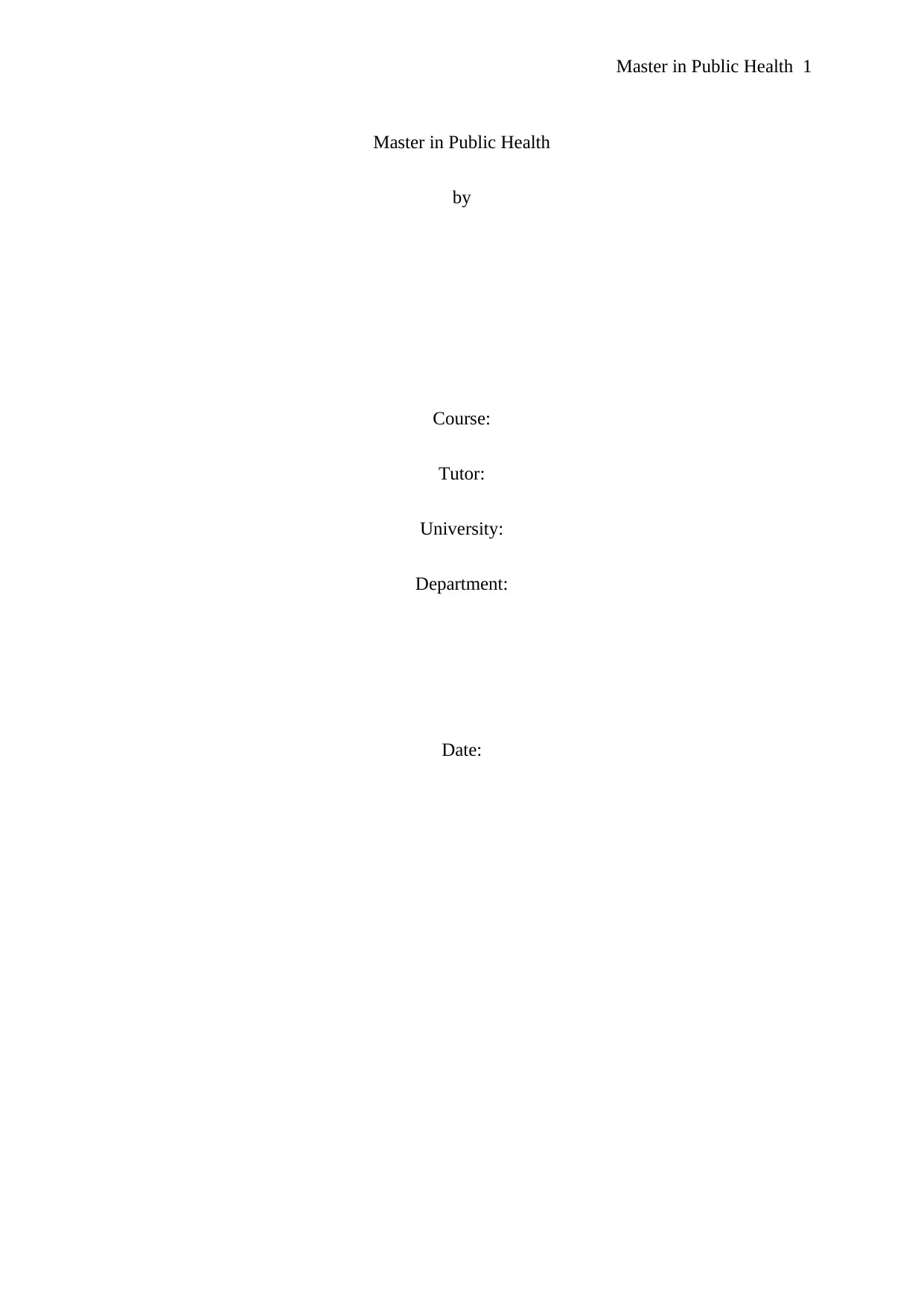
Master in Public Health 1
Master in Public Health
by
Course:
Tutor:
University:
Department:
Date:
Master in Public Health
by
Course:
Tutor:
University:
Department:
Date:
Paraphrase This Document
Need a fresh take? Get an instant paraphrase of this document with our AI Paraphraser
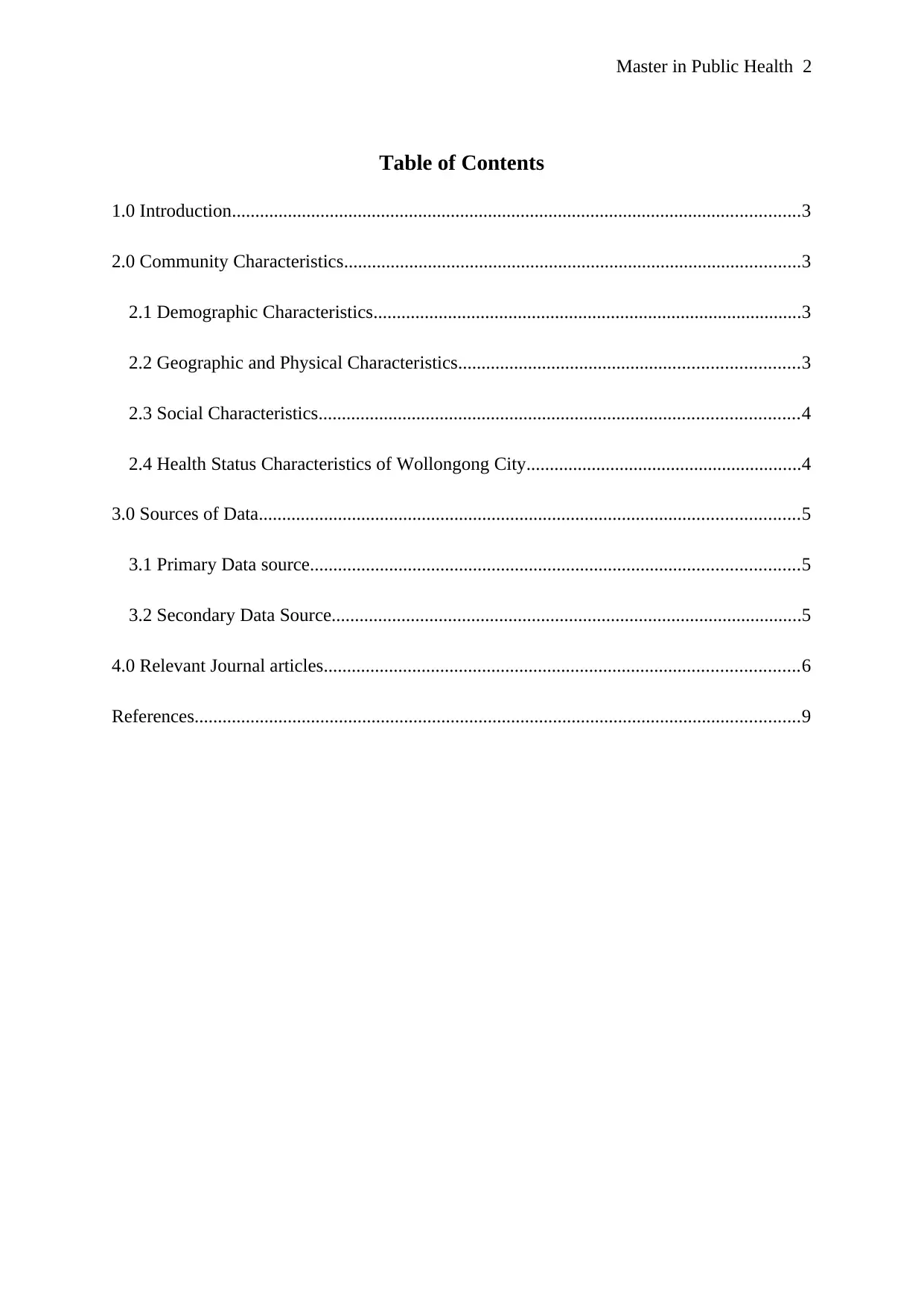
Master in Public Health 2
Table of Contents
1.0 Introduction..........................................................................................................................3
2.0 Community Characteristics..................................................................................................3
2.1 Demographic Characteristics............................................................................................3
2.2 Geographic and Physical Characteristics.........................................................................3
2.3 Social Characteristics.......................................................................................................4
2.4 Health Status Characteristics of Wollongong City...........................................................4
3.0 Sources of Data....................................................................................................................5
3.1 Primary Data source.........................................................................................................5
3.2 Secondary Data Source.....................................................................................................5
4.0 Relevant Journal articles......................................................................................................6
References..................................................................................................................................9
Table of Contents
1.0 Introduction..........................................................................................................................3
2.0 Community Characteristics..................................................................................................3
2.1 Demographic Characteristics............................................................................................3
2.2 Geographic and Physical Characteristics.........................................................................3
2.3 Social Characteristics.......................................................................................................4
2.4 Health Status Characteristics of Wollongong City...........................................................4
3.0 Sources of Data....................................................................................................................5
3.1 Primary Data source.........................................................................................................5
3.2 Secondary Data Source.....................................................................................................5
4.0 Relevant Journal articles......................................................................................................6
References..................................................................................................................................9
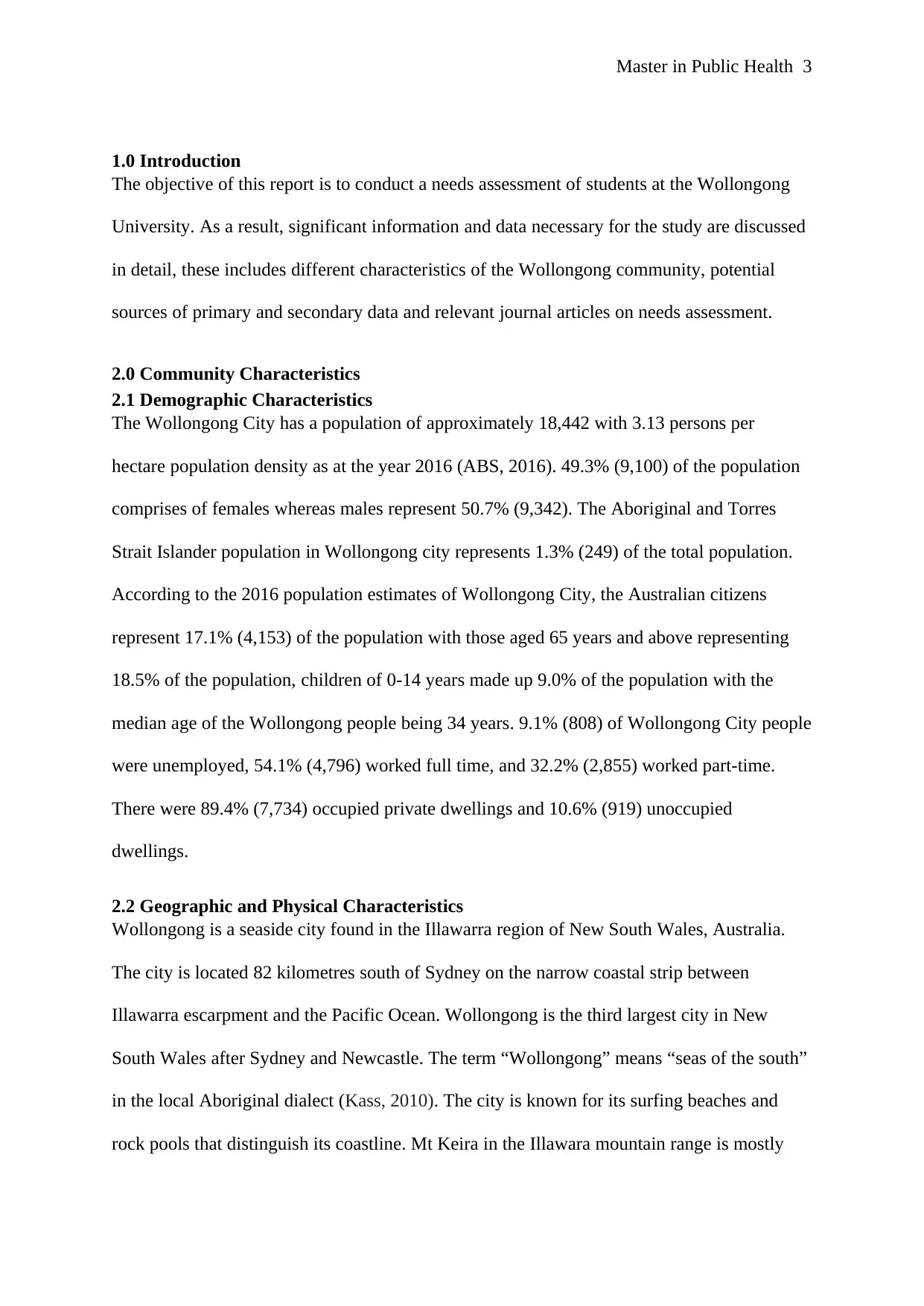
Master in Public Health 3
1.0 Introduction
The objective of this report is to conduct a needs assessment of students at the Wollongong
University. As a result, significant information and data necessary for the study are discussed
in detail, these includes different characteristics of the Wollongong community, potential
sources of primary and secondary data and relevant journal articles on needs assessment.
2.0 Community Characteristics
2.1 Demographic Characteristics
The Wollongong City has a population of approximately 18,442 with 3.13 persons per
hectare population density as at the year 2016 (ABS, 2016). 49.3% (9,100) of the population
comprises of females whereas males represent 50.7% (9,342). The Aboriginal and Torres
Strait Islander population in Wollongong city represents 1.3% (249) of the total population.
According to the 2016 population estimates of Wollongong City, the Australian citizens
represent 17.1% (4,153) of the population with those aged 65 years and above representing
18.5% of the population, children of 0-14 years made up 9.0% of the population with the
median age of the Wollongong people being 34 years. 9.1% (808) of Wollongong City people
were unemployed, 54.1% (4,796) worked full time, and 32.2% (2,855) worked part-time.
There were 89.4% (7,734) occupied private dwellings and 10.6% (919) unoccupied
dwellings.
2.2 Geographic and Physical Characteristics
Wollongong is a seaside city found in the Illawarra region of New South Wales, Australia.
The city is located 82 kilometres south of Sydney on the narrow coastal strip between
Illawarra escarpment and the Pacific Ocean. Wollongong is the third largest city in New
South Wales after Sydney and Newcastle. The term “Wollongong” means “seas of the south”
in the local Aboriginal dialect (Kass, 2010). The city is known for its surfing beaches and
rock pools that distinguish its coastline. Mt Keira in the Illawara mountain range is mostly
1.0 Introduction
The objective of this report is to conduct a needs assessment of students at the Wollongong
University. As a result, significant information and data necessary for the study are discussed
in detail, these includes different characteristics of the Wollongong community, potential
sources of primary and secondary data and relevant journal articles on needs assessment.
2.0 Community Characteristics
2.1 Demographic Characteristics
The Wollongong City has a population of approximately 18,442 with 3.13 persons per
hectare population density as at the year 2016 (ABS, 2016). 49.3% (9,100) of the population
comprises of females whereas males represent 50.7% (9,342). The Aboriginal and Torres
Strait Islander population in Wollongong city represents 1.3% (249) of the total population.
According to the 2016 population estimates of Wollongong City, the Australian citizens
represent 17.1% (4,153) of the population with those aged 65 years and above representing
18.5% of the population, children of 0-14 years made up 9.0% of the population with the
median age of the Wollongong people being 34 years. 9.1% (808) of Wollongong City people
were unemployed, 54.1% (4,796) worked full time, and 32.2% (2,855) worked part-time.
There were 89.4% (7,734) occupied private dwellings and 10.6% (919) unoccupied
dwellings.
2.2 Geographic and Physical Characteristics
Wollongong is a seaside city found in the Illawarra region of New South Wales, Australia.
The city is located 82 kilometres south of Sydney on the narrow coastal strip between
Illawarra escarpment and the Pacific Ocean. Wollongong is the third largest city in New
South Wales after Sydney and Newcastle. The term “Wollongong” means “seas of the south”
in the local Aboriginal dialect (Kass, 2010). The city is known for its surfing beaches and
rock pools that distinguish its coastline. Mt Keira in the Illawara mountain range is mostly
⊘ This is a preview!⊘
Do you want full access?
Subscribe today to unlock all pages.

Trusted by 1+ million students worldwide
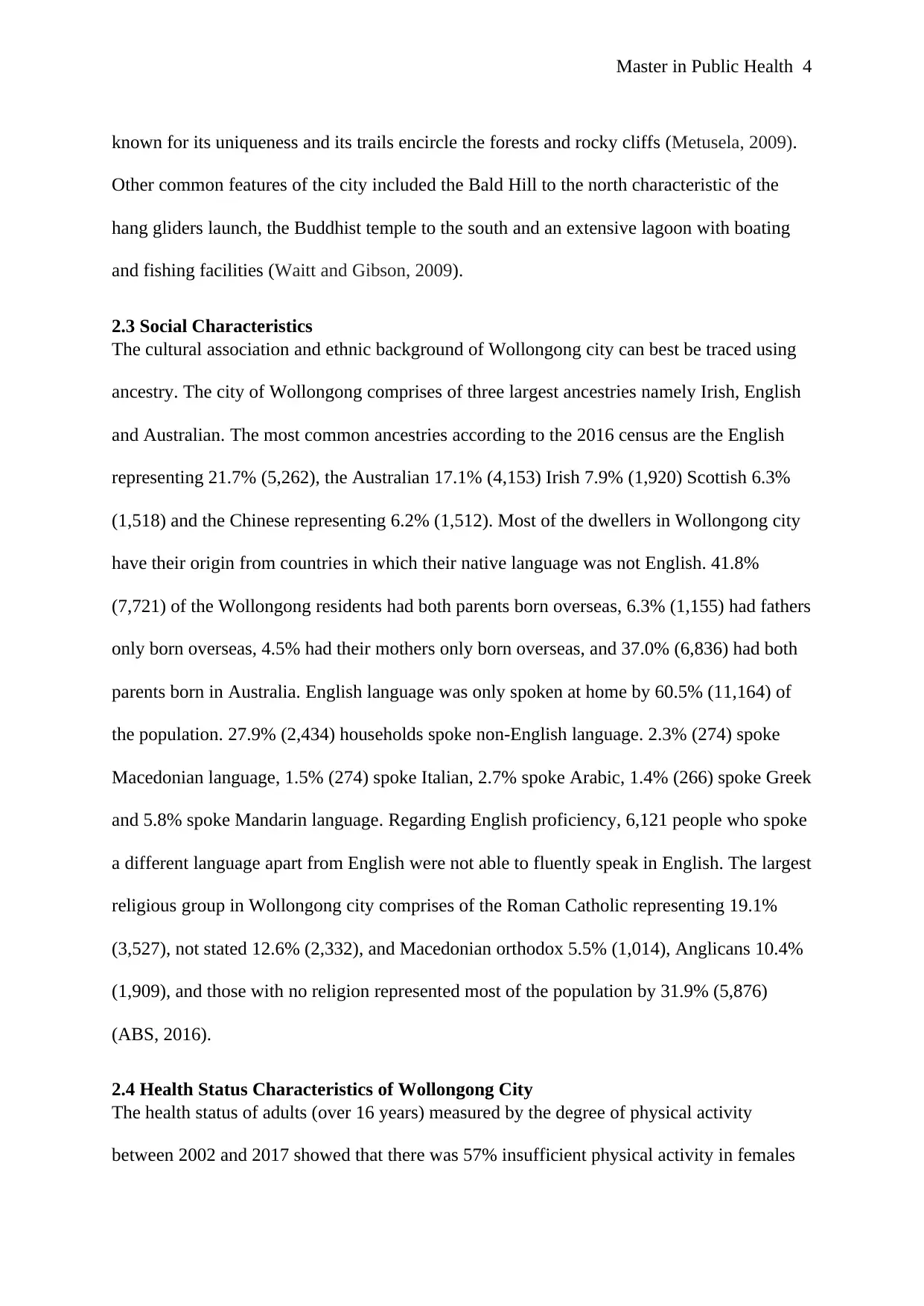
Master in Public Health 4
known for its uniqueness and its trails encircle the forests and rocky cliffs (Metusela, 2009).
Other common features of the city included the Bald Hill to the north characteristic of the
hang gliders launch, the Buddhist temple to the south and an extensive lagoon with boating
and fishing facilities (Waitt and Gibson, 2009).
2.3 Social Characteristics
The cultural association and ethnic background of Wollongong city can best be traced using
ancestry. The city of Wollongong comprises of three largest ancestries namely Irish, English
and Australian. The most common ancestries according to the 2016 census are the English
representing 21.7% (5,262), the Australian 17.1% (4,153) Irish 7.9% (1,920) Scottish 6.3%
(1,518) and the Chinese representing 6.2% (1,512). Most of the dwellers in Wollongong city
have their origin from countries in which their native language was not English. 41.8%
(7,721) of the Wollongong residents had both parents born overseas, 6.3% (1,155) had fathers
only born overseas, 4.5% had their mothers only born overseas, and 37.0% (6,836) had both
parents born in Australia. English language was only spoken at home by 60.5% (11,164) of
the population. 27.9% (2,434) households spoke non-English language. 2.3% (274) spoke
Macedonian language, 1.5% (274) spoke Italian, 2.7% spoke Arabic, 1.4% (266) spoke Greek
and 5.8% spoke Mandarin language. Regarding English proficiency, 6,121 people who spoke
a different language apart from English were not able to fluently speak in English. The largest
religious group in Wollongong city comprises of the Roman Catholic representing 19.1%
(3,527), not stated 12.6% (2,332), and Macedonian orthodox 5.5% (1,014), Anglicans 10.4%
(1,909), and those with no religion represented most of the population by 31.9% (5,876)
(ABS, 2016).
2.4 Health Status Characteristics of Wollongong City
The health status of adults (over 16 years) measured by the degree of physical activity
between 2002 and 2017 showed that there was 57% insufficient physical activity in females
known for its uniqueness and its trails encircle the forests and rocky cliffs (Metusela, 2009).
Other common features of the city included the Bald Hill to the north characteristic of the
hang gliders launch, the Buddhist temple to the south and an extensive lagoon with boating
and fishing facilities (Waitt and Gibson, 2009).
2.3 Social Characteristics
The cultural association and ethnic background of Wollongong city can best be traced using
ancestry. The city of Wollongong comprises of three largest ancestries namely Irish, English
and Australian. The most common ancestries according to the 2016 census are the English
representing 21.7% (5,262), the Australian 17.1% (4,153) Irish 7.9% (1,920) Scottish 6.3%
(1,518) and the Chinese representing 6.2% (1,512). Most of the dwellers in Wollongong city
have their origin from countries in which their native language was not English. 41.8%
(7,721) of the Wollongong residents had both parents born overseas, 6.3% (1,155) had fathers
only born overseas, 4.5% had their mothers only born overseas, and 37.0% (6,836) had both
parents born in Australia. English language was only spoken at home by 60.5% (11,164) of
the population. 27.9% (2,434) households spoke non-English language. 2.3% (274) spoke
Macedonian language, 1.5% (274) spoke Italian, 2.7% spoke Arabic, 1.4% (266) spoke Greek
and 5.8% spoke Mandarin language. Regarding English proficiency, 6,121 people who spoke
a different language apart from English were not able to fluently speak in English. The largest
religious group in Wollongong city comprises of the Roman Catholic representing 19.1%
(3,527), not stated 12.6% (2,332), and Macedonian orthodox 5.5% (1,014), Anglicans 10.4%
(1,909), and those with no religion represented most of the population by 31.9% (5,876)
(ABS, 2016).
2.4 Health Status Characteristics of Wollongong City
The health status of adults (over 16 years) measured by the degree of physical activity
between 2002 and 2017 showed that there was 57% insufficient physical activity in females
Paraphrase This Document
Need a fresh take? Get an instant paraphrase of this document with our AI Paraphraser

Master in Public Health 5
with men being rated at 49%. The weekly median income for people of fifteen years and
above was $573, family income was $ 1,546, and household income was $1,180 (ABS,
2016).
Wollongong University has 34,144 students enrolled for various courses with 26,587 students
living in Australia. There are 179 nationalities represented at the university (University of
Wollongong Australia, 2018)
3.0 Sources of Data
3.1 Primary Data source
Primary data is data that is original data that is acquired by the researcher for the first time
(Smith, 2015) In order to have a proper understanding of the Wollongong community, I will
randomly engage few people in the community by conducting interviews with an aim of
understanding the community. This will begin with meeting the local leadership to find out
the history behind the city and the trends in the population increase. Additionally, I will
obtain information on the general culture of the community, their dietary habits, disease
incidences, and the overall socio-economic activities of the people. Primary data will enable
me to obtain original and relevant information on the research topic thus increasing the
degree of accuracy of my findings. The data will also provide a detailed understanding on the
general attitude of the people towards health and the main factors that influence their dietary
habits
3.2 Secondary Data Source
The Australian Bureau of Statistics Census of 2016 of Wollongong City will be a rich source
of secondary data which will help in a proper understanding of the Wollongong community.
The specific type of information or data that will be acquired from the census include the
demographics of Wollongong city with respect to age, gender, Indigenous population,
cultural and language diversity, employment status, and dwellings. Such a wealth of
with men being rated at 49%. The weekly median income for people of fifteen years and
above was $573, family income was $ 1,546, and household income was $1,180 (ABS,
2016).
Wollongong University has 34,144 students enrolled for various courses with 26,587 students
living in Australia. There are 179 nationalities represented at the university (University of
Wollongong Australia, 2018)
3.0 Sources of Data
3.1 Primary Data source
Primary data is data that is original data that is acquired by the researcher for the first time
(Smith, 2015) In order to have a proper understanding of the Wollongong community, I will
randomly engage few people in the community by conducting interviews with an aim of
understanding the community. This will begin with meeting the local leadership to find out
the history behind the city and the trends in the population increase. Additionally, I will
obtain information on the general culture of the community, their dietary habits, disease
incidences, and the overall socio-economic activities of the people. Primary data will enable
me to obtain original and relevant information on the research topic thus increasing the
degree of accuracy of my findings. The data will also provide a detailed understanding on the
general attitude of the people towards health and the main factors that influence their dietary
habits
3.2 Secondary Data Source
The Australian Bureau of Statistics Census of 2016 of Wollongong City will be a rich source
of secondary data which will help in a proper understanding of the Wollongong community.
The specific type of information or data that will be acquired from the census include the
demographics of Wollongong city with respect to age, gender, Indigenous population,
cultural and language diversity, employment status, and dwellings. Such a wealth of
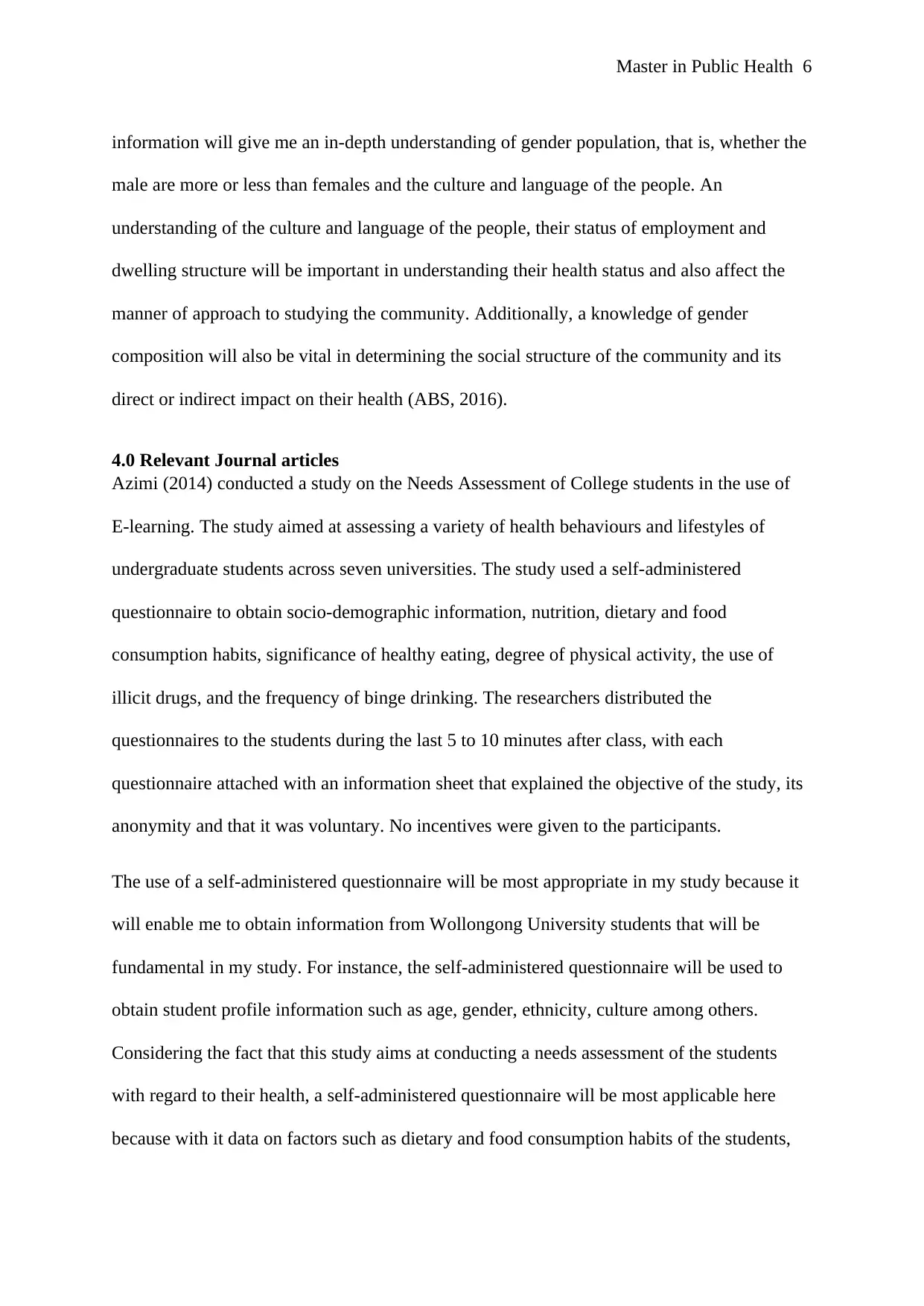
Master in Public Health 6
information will give me an in-depth understanding of gender population, that is, whether the
male are more or less than females and the culture and language of the people. An
understanding of the culture and language of the people, their status of employment and
dwelling structure will be important in understanding their health status and also affect the
manner of approach to studying the community. Additionally, a knowledge of gender
composition will also be vital in determining the social structure of the community and its
direct or indirect impact on their health (ABS, 2016).
4.0 Relevant Journal articles
Azimi (2014) conducted a study on the Needs Assessment of College students in the use of
E-learning. The study aimed at assessing a variety of health behaviours and lifestyles of
undergraduate students across seven universities. The study used a self-administered
questionnaire to obtain socio-demographic information, nutrition, dietary and food
consumption habits, significance of healthy eating, degree of physical activity, the use of
illicit drugs, and the frequency of binge drinking. The researchers distributed the
questionnaires to the students during the last 5 to 10 minutes after class, with each
questionnaire attached with an information sheet that explained the objective of the study, its
anonymity and that it was voluntary. No incentives were given to the participants.
The use of a self-administered questionnaire will be most appropriate in my study because it
will enable me to obtain information from Wollongong University students that will be
fundamental in my study. For instance, the self-administered questionnaire will be used to
obtain student profile information such as age, gender, ethnicity, culture among others.
Considering the fact that this study aims at conducting a needs assessment of the students
with regard to their health, a self-administered questionnaire will be most applicable here
because with it data on factors such as dietary and food consumption habits of the students,
information will give me an in-depth understanding of gender population, that is, whether the
male are more or less than females and the culture and language of the people. An
understanding of the culture and language of the people, their status of employment and
dwelling structure will be important in understanding their health status and also affect the
manner of approach to studying the community. Additionally, a knowledge of gender
composition will also be vital in determining the social structure of the community and its
direct or indirect impact on their health (ABS, 2016).
4.0 Relevant Journal articles
Azimi (2014) conducted a study on the Needs Assessment of College students in the use of
E-learning. The study aimed at assessing a variety of health behaviours and lifestyles of
undergraduate students across seven universities. The study used a self-administered
questionnaire to obtain socio-demographic information, nutrition, dietary and food
consumption habits, significance of healthy eating, degree of physical activity, the use of
illicit drugs, and the frequency of binge drinking. The researchers distributed the
questionnaires to the students during the last 5 to 10 minutes after class, with each
questionnaire attached with an information sheet that explained the objective of the study, its
anonymity and that it was voluntary. No incentives were given to the participants.
The use of a self-administered questionnaire will be most appropriate in my study because it
will enable me to obtain information from Wollongong University students that will be
fundamental in my study. For instance, the self-administered questionnaire will be used to
obtain student profile information such as age, gender, ethnicity, culture among others.
Considering the fact that this study aims at conducting a needs assessment of the students
with regard to their health, a self-administered questionnaire will be most applicable here
because with it data on factors such as dietary and food consumption habits of the students,
⊘ This is a preview!⊘
Do you want full access?
Subscribe today to unlock all pages.

Trusted by 1+ million students worldwide
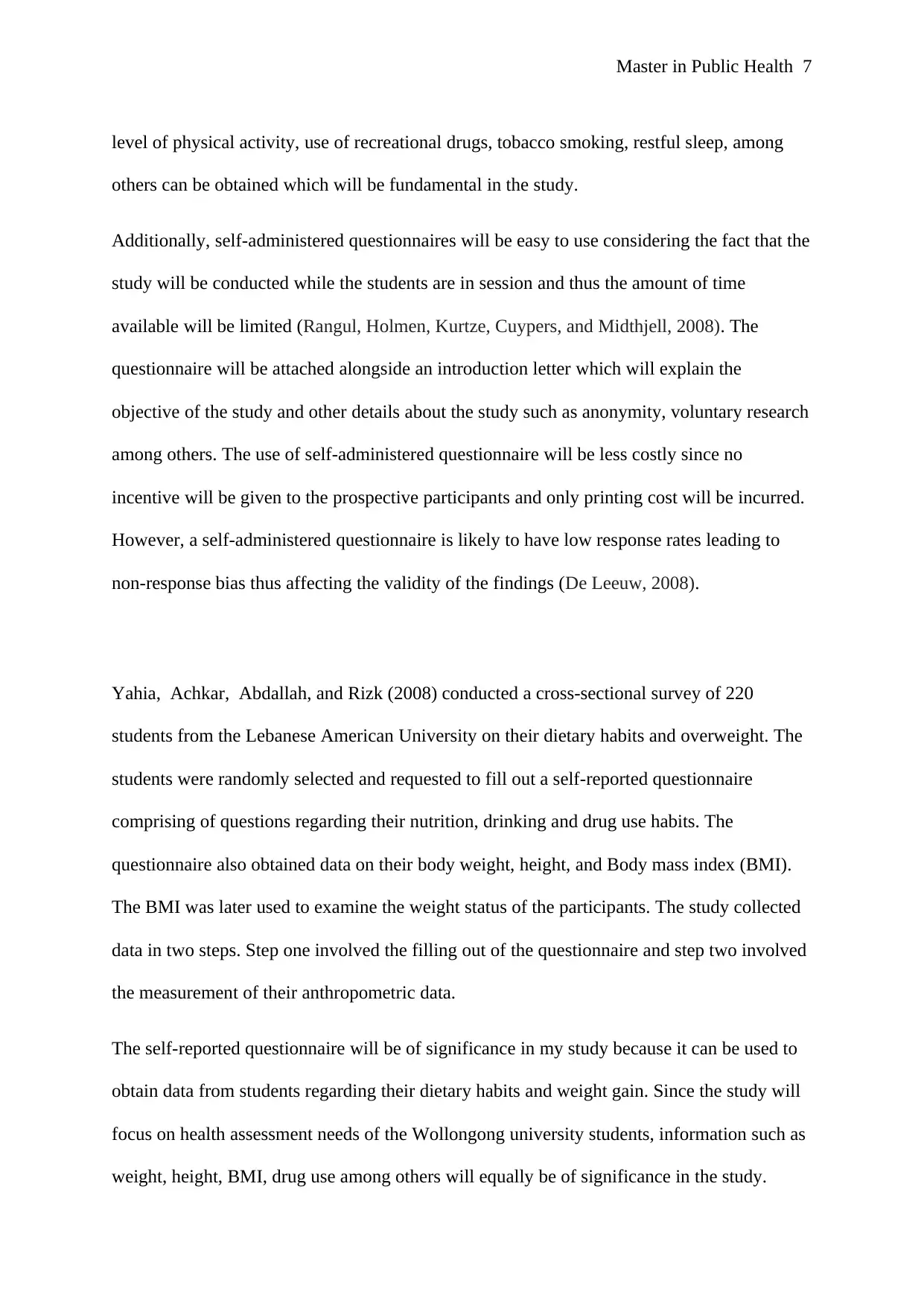
Master in Public Health 7
level of physical activity, use of recreational drugs, tobacco smoking, restful sleep, among
others can be obtained which will be fundamental in the study.
Additionally, self-administered questionnaires will be easy to use considering the fact that the
study will be conducted while the students are in session and thus the amount of time
available will be limited (Rangul, Holmen, Kurtze, Cuypers, and Midthjell, 2008). The
questionnaire will be attached alongside an introduction letter which will explain the
objective of the study and other details about the study such as anonymity, voluntary research
among others. The use of self-administered questionnaire will be less costly since no
incentive will be given to the prospective participants and only printing cost will be incurred.
However, a self-administered questionnaire is likely to have low response rates leading to
non-response bias thus affecting the validity of the findings (De Leeuw, 2008).
Yahia, Achkar, Abdallah, and Rizk (2008) conducted a cross-sectional survey of 220
students from the Lebanese American University on their dietary habits and overweight. The
students were randomly selected and requested to fill out a self-reported questionnaire
comprising of questions regarding their nutrition, drinking and drug use habits. The
questionnaire also obtained data on their body weight, height, and Body mass index (BMI).
The BMI was later used to examine the weight status of the participants. The study collected
data in two steps. Step one involved the filling out of the questionnaire and step two involved
the measurement of their anthropometric data.
The self-reported questionnaire will be of significance in my study because it can be used to
obtain data from students regarding their dietary habits and weight gain. Since the study will
focus on health assessment needs of the Wollongong university students, information such as
weight, height, BMI, drug use among others will equally be of significance in the study.
level of physical activity, use of recreational drugs, tobacco smoking, restful sleep, among
others can be obtained which will be fundamental in the study.
Additionally, self-administered questionnaires will be easy to use considering the fact that the
study will be conducted while the students are in session and thus the amount of time
available will be limited (Rangul, Holmen, Kurtze, Cuypers, and Midthjell, 2008). The
questionnaire will be attached alongside an introduction letter which will explain the
objective of the study and other details about the study such as anonymity, voluntary research
among others. The use of self-administered questionnaire will be less costly since no
incentive will be given to the prospective participants and only printing cost will be incurred.
However, a self-administered questionnaire is likely to have low response rates leading to
non-response bias thus affecting the validity of the findings (De Leeuw, 2008).
Yahia, Achkar, Abdallah, and Rizk (2008) conducted a cross-sectional survey of 220
students from the Lebanese American University on their dietary habits and overweight. The
students were randomly selected and requested to fill out a self-reported questionnaire
comprising of questions regarding their nutrition, drinking and drug use habits. The
questionnaire also obtained data on their body weight, height, and Body mass index (BMI).
The BMI was later used to examine the weight status of the participants. The study collected
data in two steps. Step one involved the filling out of the questionnaire and step two involved
the measurement of their anthropometric data.
The self-reported questionnaire will be of significance in my study because it can be used to
obtain data from students regarding their dietary habits and weight gain. Since the study will
focus on health assessment needs of the Wollongong university students, information such as
weight, height, BMI, drug use among others will equally be of significance in the study.
Paraphrase This Document
Need a fresh take? Get an instant paraphrase of this document with our AI Paraphraser
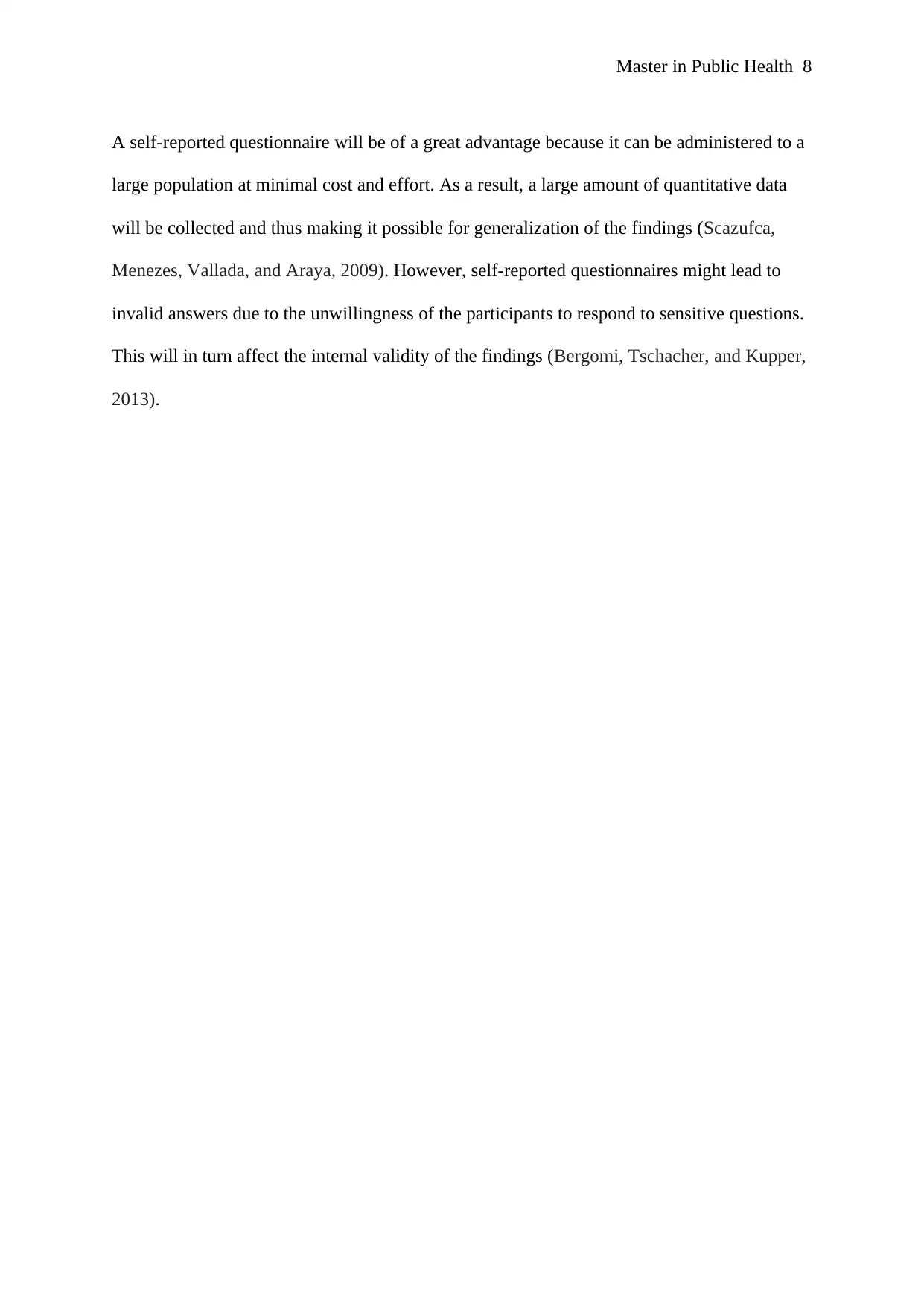
Master in Public Health 8
A self-reported questionnaire will be of a great advantage because it can be administered to a
large population at minimal cost and effort. As a result, a large amount of quantitative data
will be collected and thus making it possible for generalization of the findings (Scazufca,
Menezes, Vallada, and Araya, 2009). However, self-reported questionnaires might lead to
invalid answers due to the unwillingness of the participants to respond to sensitive questions.
This will in turn affect the internal validity of the findings (Bergomi, Tschacher, and Kupper,
2013).
A self-reported questionnaire will be of a great advantage because it can be administered to a
large population at minimal cost and effort. As a result, a large amount of quantitative data
will be collected and thus making it possible for generalization of the findings (Scazufca,
Menezes, Vallada, and Araya, 2009). However, self-reported questionnaires might lead to
invalid answers due to the unwillingness of the participants to respond to sensitive questions.
This will in turn affect the internal validity of the findings (Bergomi, Tschacher, and Kupper,
2013).
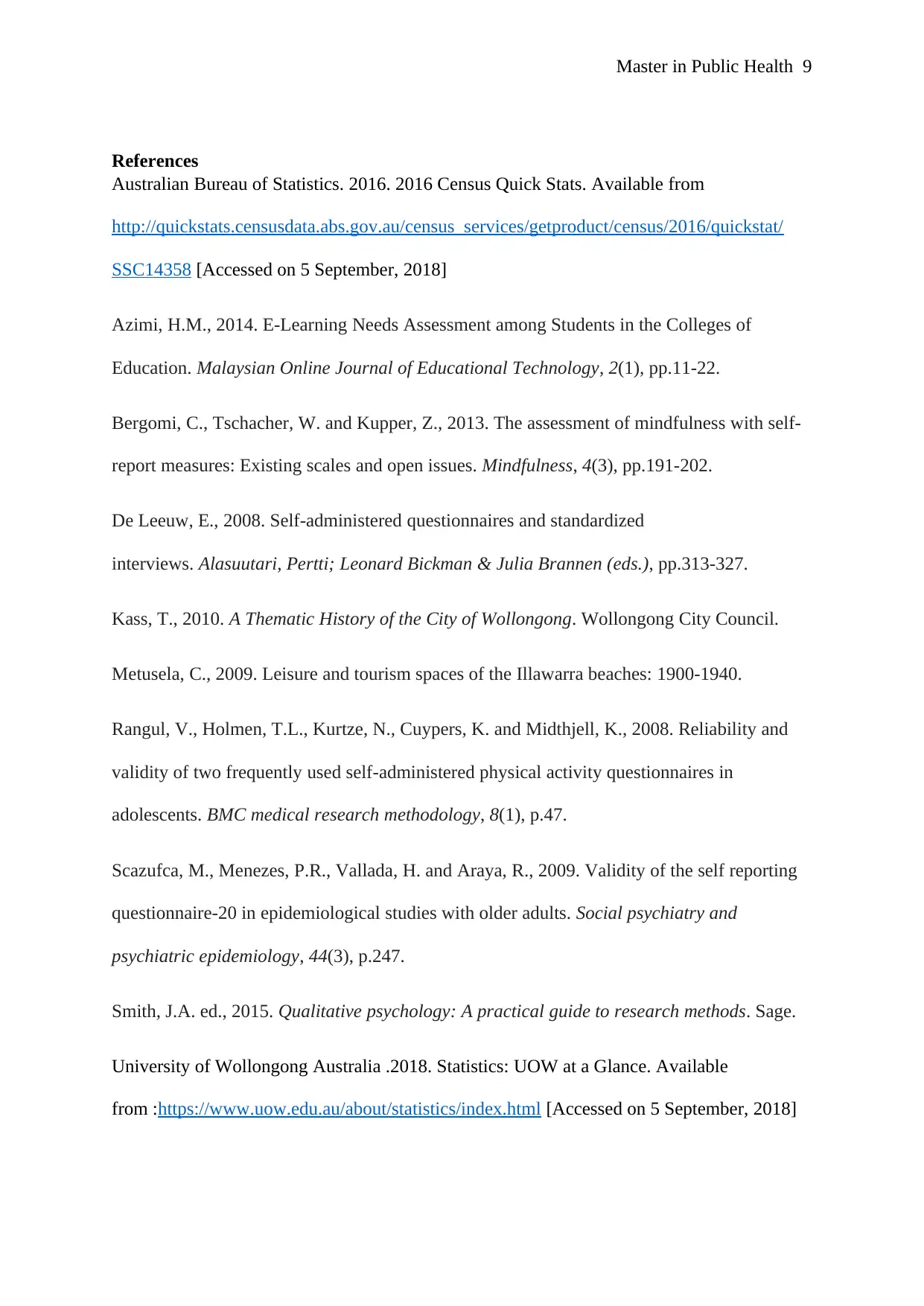
Master in Public Health 9
References
Australian Bureau of Statistics. 2016. 2016 Census Quick Stats. Available from
http://quickstats.censusdata.abs.gov.au/census_services/getproduct/census/2016/quickstat/
SSC14358 [Accessed on 5 September, 2018]
Azimi, H.M., 2014. E-Learning Needs Assessment among Students in the Colleges of
Education. Malaysian Online Journal of Educational Technology, 2(1), pp.11-22.
Bergomi, C., Tschacher, W. and Kupper, Z., 2013. The assessment of mindfulness with self-
report measures: Existing scales and open issues. Mindfulness, 4(3), pp.191-202.
De Leeuw, E., 2008. Self-administered questionnaires and standardized
interviews. Alasuutari, Pertti; Leonard Bickman & Julia Brannen (eds.), pp.313-327.
Kass, T., 2010. A Thematic History of the City of Wollongong. Wollongong City Council.
Metusela, C., 2009. Leisure and tourism spaces of the Illawarra beaches: 1900-1940.
Rangul, V., Holmen, T.L., Kurtze, N., Cuypers, K. and Midthjell, K., 2008. Reliability and
validity of two frequently used self-administered physical activity questionnaires in
adolescents. BMC medical research methodology, 8(1), p.47.
Scazufca, M., Menezes, P.R., Vallada, H. and Araya, R., 2009. Validity of the self reporting
questionnaire-20 in epidemiological studies with older adults. Social psychiatry and
psychiatric epidemiology, 44(3), p.247.
Smith, J.A. ed., 2015. Qualitative psychology: A practical guide to research methods. Sage.
University of Wollongong Australia .2018. Statistics: UOW at a Glance. Available
from :https://www.uow.edu.au/about/statistics/index.html [Accessed on 5 September, 2018]
References
Australian Bureau of Statistics. 2016. 2016 Census Quick Stats. Available from
http://quickstats.censusdata.abs.gov.au/census_services/getproduct/census/2016/quickstat/
SSC14358 [Accessed on 5 September, 2018]
Azimi, H.M., 2014. E-Learning Needs Assessment among Students in the Colleges of
Education. Malaysian Online Journal of Educational Technology, 2(1), pp.11-22.
Bergomi, C., Tschacher, W. and Kupper, Z., 2013. The assessment of mindfulness with self-
report measures: Existing scales and open issues. Mindfulness, 4(3), pp.191-202.
De Leeuw, E., 2008. Self-administered questionnaires and standardized
interviews. Alasuutari, Pertti; Leonard Bickman & Julia Brannen (eds.), pp.313-327.
Kass, T., 2010. A Thematic History of the City of Wollongong. Wollongong City Council.
Metusela, C., 2009. Leisure and tourism spaces of the Illawarra beaches: 1900-1940.
Rangul, V., Holmen, T.L., Kurtze, N., Cuypers, K. and Midthjell, K., 2008. Reliability and
validity of two frequently used self-administered physical activity questionnaires in
adolescents. BMC medical research methodology, 8(1), p.47.
Scazufca, M., Menezes, P.R., Vallada, H. and Araya, R., 2009. Validity of the self reporting
questionnaire-20 in epidemiological studies with older adults. Social psychiatry and
psychiatric epidemiology, 44(3), p.247.
Smith, J.A. ed., 2015. Qualitative psychology: A practical guide to research methods. Sage.
University of Wollongong Australia .2018. Statistics: UOW at a Glance. Available
from :https://www.uow.edu.au/about/statistics/index.html [Accessed on 5 September, 2018]
⊘ This is a preview!⊘
Do you want full access?
Subscribe today to unlock all pages.

Trusted by 1+ million students worldwide
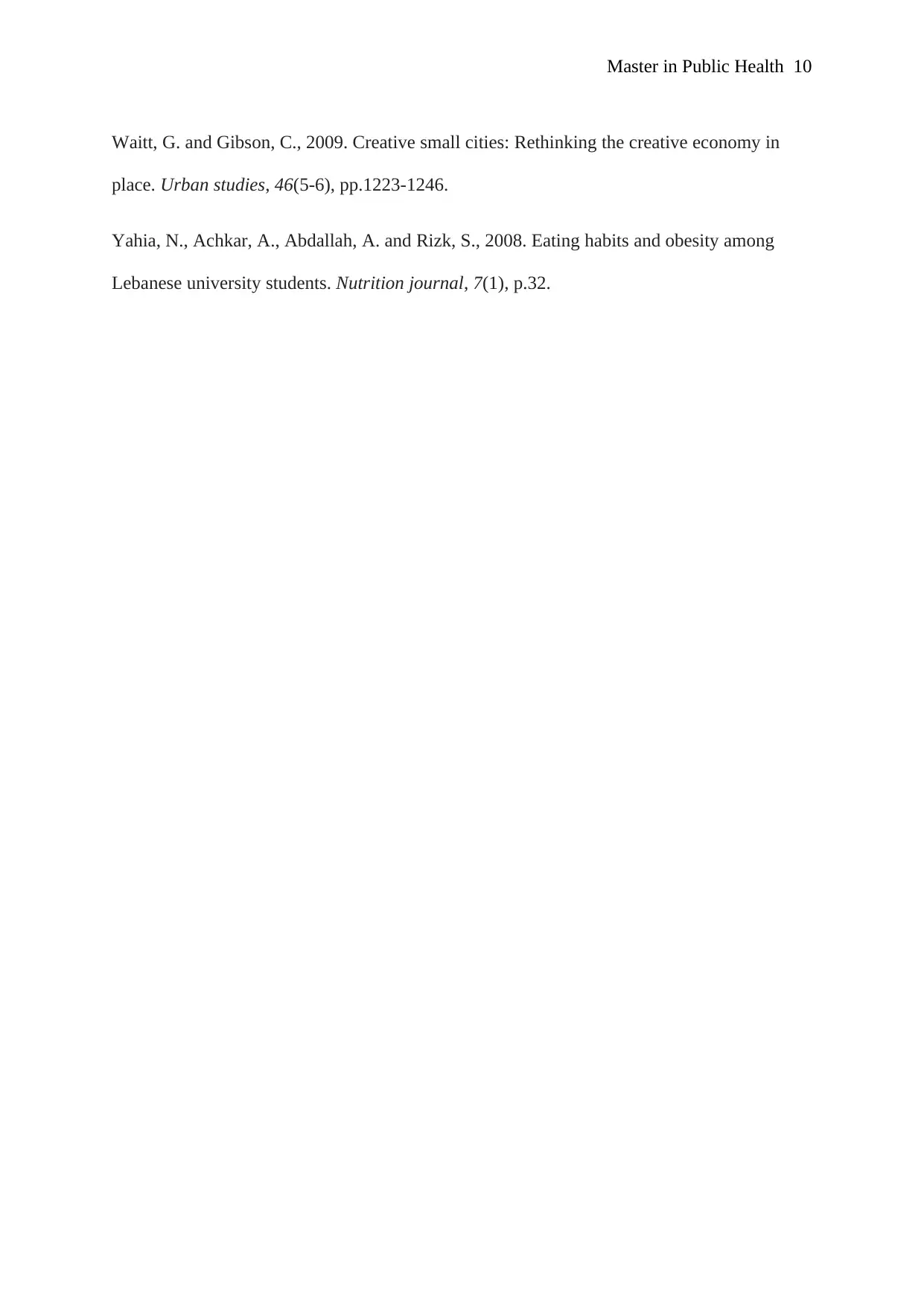
Master in Public Health 10
Waitt, G. and Gibson, C., 2009. Creative small cities: Rethinking the creative economy in
place. Urban studies, 46(5-6), pp.1223-1246.
Yahia, N., Achkar, A., Abdallah, A. and Rizk, S., 2008. Eating habits and obesity among
Lebanese university students. Nutrition journal, 7(1), p.32.
Waitt, G. and Gibson, C., 2009. Creative small cities: Rethinking the creative economy in
place. Urban studies, 46(5-6), pp.1223-1246.
Yahia, N., Achkar, A., Abdallah, A. and Rizk, S., 2008. Eating habits and obesity among
Lebanese university students. Nutrition journal, 7(1), p.32.
1 out of 10
Your All-in-One AI-Powered Toolkit for Academic Success.
+13062052269
info@desklib.com
Available 24*7 on WhatsApp / Email
![[object Object]](/_next/static/media/star-bottom.7253800d.svg)
Unlock your academic potential
Copyright © 2020–2025 A2Z Services. All Rights Reserved. Developed and managed by ZUCOL.


